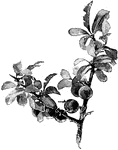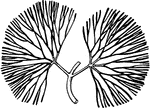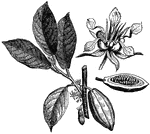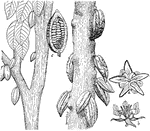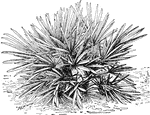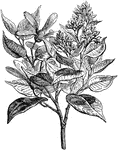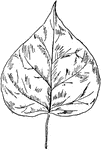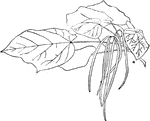252 illustrations of trees including: cabbage palmetto, cabomba, cacao, calabash, California black oak, California juniper, camphor, Canadian hemlock, cannon ball tree, Caribbean pine, cashew, chapman Oak, cherimoya, cherry, chestnut, cinnamon, citron, clove tree, cocao, cocoanut palm, coffee tree, common Juniper, copaiva tree, copal, and corkwood.

Chestnut Branch
A chestnut branch. Chestnuts branches are usually green in color and have edible nuts.
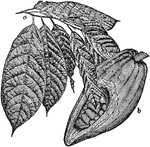
Cacao Fruit and Leaves
"Cocoa. a.-- branch with leaves; b.-- fruit (partly in section). Cacao (or Cocoa), the chocolate tree…

Cacao Plant
"Cacao, or cocoa, is the chocolate tree, and also the powder and beverage made with it obtained from…
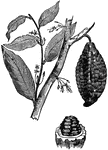
Cacao Tree
"The cocoa, or as it should be written,cacao, tree is an evergreen, and it said to bear some resemblance…
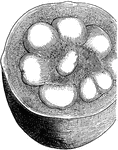
Black Calabash Fruit
A cross section of the fruit of the black calabash tree (Crescentia cucurbitina), native to Florida.
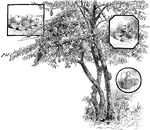
Calabash Tree
An illustration of a Calabash tree and ways to utilize the shell of the fruit it produces. Crescentia…
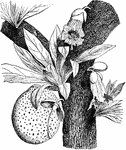
Calabash Tree
A tree of tropical America bearing a gourd like fruit. The hard shell of which is applied to many domestic…
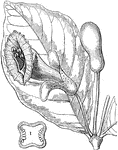
Black Calabash Tree
Native to Florida, Crescentia obovata or the Black Calabash tree is a flowering plant of the Bignoniaceae…

Calamites
"Calamites (a restored); b enlarged fig.; c, d, e, leaflets and branches; f catkin; g root." -Taylor,…

Branch of California Black Oak
Also known as Quercus kelloggii. The branch of a California Black Oak, native to western North America.

Branch of California Black Walnut
Also known as Juglans californica. A species of walnut shrub endemic to California.

Branch of California Juniper
Also known as Juniperus californica. A species of juniper native mainly to California.

Branch of California Wax Myrtle
Also known as Myrica californica. A small tree native to the Pacific Coast of North America.
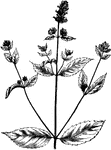
Camphor Tree
"An evergreen of the laurel family, having glossy leaves and bearing clusters of yellowish flowers,…
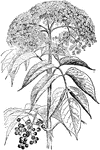
Sambucus Canadensis
Common elder of central and eastern North America bearing purple-black berries; fruit used in wines…

Branch of Canadian Hemlock
Also known as Tsuga canadensis. A coniferous tree native to eastern North America.
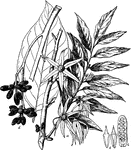
Canangium Odoratum
Illustrated is a flowering branch (a), the stamens (b), a longitudinal section of fruit (c), and a fruit…
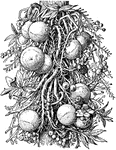
Cannon Ball Tree
Cannon ball tree is the common name of couroupita guianensis. Illustrated is the trunk and the hanging…

Branch of Canyon Live Oak
Also known as Quercus chrysolepis. The branch of a Canyon Live Oak tree, native to the southwestern…

Branch of Capparis Jamaicensis
A branch from the Capparis jamaicensis tree, native to Florida during the spring season.

Carludovica Palmata
Carludovica palmata has no trunk. The blades are four lobed. The blades are dark green and gracefully…

Carob Tree
Native to countries around the Mediterranean. The pods are often called locust-eans, are supposed by…

Pine Cone of Carolina Hemlock
Also known as Tsuga caroliniana. An evergreen coniferous tree native to the Appalachian Mountains.
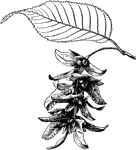
Carpinus Caroliniana
The common names of carpinus caroliniana are American hornbeam and blue beech. The leaves are oval,…
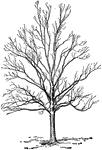
Carya Glabra
The common name of carya glabra is pignut or pignut hickory. Illustrated is the characteristic growth…
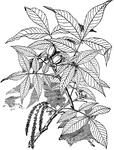
Carya Ovalis
The common names of carya ovalis are false shagbark and small pignut. There are five to seven oval leaflets.

Carya Ovalis
Illustrated is the habit of carya ovalis, also known has false shagbark and small pignut.
Carya Ovalis Twig
Illustrated is a twig of carya ovalis, also known as false shagbark and small pignut.
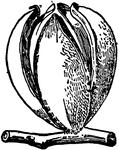
Fruit of Carya Ovalis
Illustrated is the fruit of carya ovalis. It is known as false shagbark or small pignut.

Carya Ovata Fruit
Illustrated is a cross section of the fruit and the whole fruit of carya ovata. The common names of…
Carya Ovata Twig
Illustrated is the twig of carya ovata. The common names are shagbark hickory and little shellbark hickory.

Caryota Sobolifera
Caryota sobolfera is a variety of palmae, or palm tree. This form occurs frequently.

Casearia
"Casearia grandiflora. 1. part of a calyx split open; 2. the pistil half grown; 3. section across the…
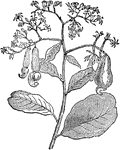
Cashew Branch
"Cashew Nut. Cashew, a tree common in the West Indies. Its fruit is called the cashew nut. The nut is…
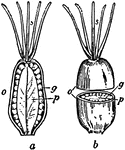
Cashew Tree
An illustration of various parts of the cashew tree. "1, Branch, bearing flowers and fruit. The fruit…

Cassipourea
"Cassipourea elliptica. 1. a flower; 2. stamens; 3. pistil; 4. cross section of the ovary." -Lindley,…
Castanea Dentata
Illustrated is the leaf of castanea dentata, a variety of chestnut. The leaf is oblong and tapers to…
Castanea Sativa
Illustrated is the leaf of castanea sativa, a variety of chestnut. The leaves are oblong and taper to…
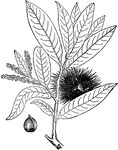
Castanopsis Chrysophylla
The castanopsis chrysophylla tree grows one hundred fifty feet tall. The leaves are oval and oblong.…

Branch of Castanopsis Chrysophylla
The branch of a Castanopsis chrysophylla, a species of beech tree.

Casuarina Equisetifolia
The casuarina equisetifolia tree can grow up to one hundred fifty feet tall. The branches are drooping…
